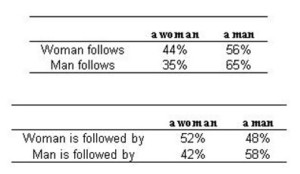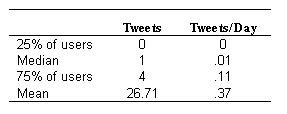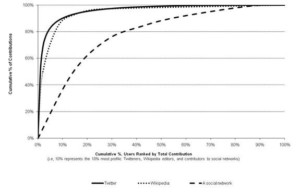2:15 PM Monday June 1, 2009
by Bill Heil and Mikolaj Piskorski
Twitter has attracted tremendous attention from the media and celebrities, but there is much uncertainty about Twitter’s purpose. Is Twitter a communications service for friends and groups, a means of expressing yourself freely, or simply a marketing tool?
We examined the activity of a random sample of 300,000 Twitter users in May 2009 to find out how people are using the service. We then compared our findings to activity on other social networks and online content production venues. Our findings are very surprising.
Of our sample (300,542 users, collected in May 2009), 80% are followed by or follow at least one user. By comparison, only 60 to 65% of other online social networks’ members had at least one friend (when these networks were at a similar level of development). This suggests that actual users (as opposed to the media at large) understand how Twitter works.
Although men and women follow a similar number of Twitter users, men have 15% more followers than women. Men also have more reciprocated relationships, in which two users follow each other. This “follower split” suggests that women are driven less by followers than men, or have more stringent thresholds for reciprocating relationships. This is intriguing, especially given that females hold a slight majority on Twitter: we found that men comprise 45% of Twitter users, while women represent 55%. To get this figure, we cross-referenced users’ “real names” against a database of 40,000 strongly gendered names.
Even more interesting is who follows whom. We found that an average man is almost twice more likely to follow another man than a woman. Similarly, an average woman is 25% more likely to follow a man than a woman. Finally, an average man is 40% more likely to be followed by another man than by a woman. These results cannot be explained by different tweeting activity – both men and women tweet at the same rate.

These results are stunning given what previous research has found in the context of online social networks. On a typical online social network, most of the activity is focused around women – men follow content produced by women they do and do not know, and women follow content produced by women they knowi. Generally, men receive comparatively little attention from other men or from women. We wonder to what extent this pattern of results arises because men and women find the content produced by other men on Twitter more compelling than on a typical social network, and men find the content produced by women less compelling (because of a lack of photo sharing, detailed biographies, etc.).
Twitter’s usage patterns are also very different from a typical on-line social network. A typical Twitter user contributes very rarely. Among Twitter users, the median number of lifetime tweets per user is one. This translates into over half of Twitter users tweeting less than once every 74 days.

At the same time there is a small contingent of users who are very active. Specifically, the top 10% of prolific Twitter users accounted for over 90% of tweets. On a typical online social network, the top 10% of users account for 30% of all production. To put Twitter in perspective, consider an unlikely analogue – Wikipedia. There, the top 15% of the most prolific editors account for 90% of Wikipedia’s edits ii. In other words, the pattern of contributions on Twitter is more concentrated among the few top users than is the case on Wikipedia, even though Wikipedia is clearly not a communications tool. This implies that Twitter’s resembles more of a one-way, one-to-many publishing service more than a two-way, peer-to-peer communication network.

Be sure to learn more about twitter for real estate by viewing our Twitterstate page – click here
Bill Heil is a graduating MBA student at Harvard Business School, and will start at Adobe Systems as a Product Manager in the fall. Mikolaj Jan Piskorski is an Assistant Professor of Strategy at HBS who teaches a Second Year elective entitled Competing with Social Networks. Bill undertook research for parts of this article in the context of that class.
i Piskorski, Mikolaj Jan. “Networks as covers: Evidence from an on-line social network.” Working Paper, Harvard Business School.
ii Piskorski, Mikolaj Jan and Andreea Gorbatai, “Social structure of collaboration on Wikipedia.” Working Paper, Harvard Business School.





Leave A Comment